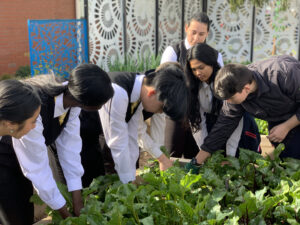
Horticultural education and the pathways to a greener future
By Michael Casey
Children and adolescents understand the future that lies ahead of them. They understand the issues relating to land degradation through careless corporate greed and the expansion of the urban fringe, and the need for smarter food systems that grow healthy and nutritious foods in a more sustainable way.
They also understand the effects the lack of contact with nature is causing them and their loved ones, through reduced outdoor time and the effects the recent pandemic is having on their normal social interactions and routines.
This need for change has seen some students tackling it head on through education and action, and working towards providing solutions to preventing the ongoing damage to our environment.
Fellow horticulturist Kieran Christopherson and I, actively lecture and educate in the spaces of horticulture, food production and security, and the integration of nature into our lives. The job of delivering Certificate 2 Horticulture to secondary senior students, who are now enrolling in great numbers, highlights to us that the future of horticulture, and the younger generation’s desire to discover a profession in nature-based solutions, is becoming very popular.

Many of our students this year have demonstrated interests in horticulture and trade related industries, conservation and youth work, to name a few. We have found that the students are self-motivated and driven to find solutions to change the world and assist in this cause.
Kieran’s passion for teaching horticulture, and encouraging a new voice amongst our profession, can be summed up with his response when asked why he enjoys teaching horticulture and the many benefits of being in and around nature.
“The world is changing at a rapid pace and by the time our students are well into adulthood, they will be the ones who will have to manage the uncertainties of our climate future. Horticultural education provides an opportunity to teach young people some of the science behind what the future holds, while also providing them with practical solutions for making a positive impact – through urban forestry, regenerative agriculture and other emerging conservation professions.”
The reason I enjoy the interest the students have displayed isn’t because of their career choices but their passion to see positive change. Many of the careers of the future that are directly related to urban greening, nature-based solutions and green policy-making, to name a few, haven’t been created yet or are currently in their infancy, and will require skills to be developed and enhanced to ensure these professions prosper. These students have a great opportunity to assist in the creation of these employment opportunities via think tanks, ongoing education or through active participation in the industry.
The World Economic Forum released a report in 2020 titled “The Future of Nature and Business” and stated that “Six complementary socio-economic transitions’* can together place the food, land and ocean-use system on a pathway to sustainable, nature-positive development. Together, the business opportunities associated with these six transitions could create almost $3.6 trillion of annual additional revenue or costs savings, while creating 191 million new jobs by 2030”. This untapped economy is on our doorstep and the current generation of students choosing a career or leaving school, now has a clear pathway into a line of professions that will develop and support their skills.
Just recently, the release of the climate report compiled by the Intergovernmental Panel on Climate Change (IPCC) 2021, stated that we are on track for a 1.5oC rise in overall temperatures. The work of future horticulturists, working towards the solutions of reversing this climate damage, can be achieved through the creation of a greener economy and nature-based solutions.
When talking to my students, I realised they all have a vested interest in horticulture and nature but with different future pathways into either social work, marine biology and conservation works, as their suggested possible career routes. This cross section of professions has them wanting to encompass horticulture and nature into their careers, and found the education Kieran and myself delivered fundamental to their interests and ongoing learning.

This is our generation’s opportunity to repair the environmental damage and apply their skills, thoughts and future pathways into careers that will be satisfying to them, and the broader community, and with ultimate benefits for the environment.
Society will welcome the creation of green spaces, green links and streetscapes to soften and cool our built environments and encourage biodiversity. Communities will celebrate the implementation of urban farming and food forests to provide safe, healthy, and nutritious food on our doorsteps, and to creating greener cities that encompass social inequality issues. More importantly, future generations will celebrate the opportunities to work in a profession that encourages and promotes these skills.
How we interact with, and relate to, nature is ingrained in our biology. To observe this connection in students through discussions, actions and behaviors, while teaching horticulture and carrying out our group activities, has been promising. Our observations are reassuring us that we will see a new generation of young adults moving into a greener profession and economy that will work at providing solutions to our changing climate.
A generation that values nature and possesses a desire to live in harmony with the planets natural system, will see the creation of some exciting new urban greening professionals. Our indigenous communities lived in close connection with the earth, and had the knowledge and dependence associated with interactions between the seasons and nature. It’s now time we did the same, mixing horticultural science and best practice, to provide a greener future.
*Six complementary socio-economic transitions – ecosystem restoration, productive and regenerative agriculture, sustainable management of oceans, sustainable management of forests, planet-combatable consumption, and transparent and sustainable supply chains.
Michael Casey MAIH RH106
Director of Evergreen Infrastructure and
MJC Horticulture.
National President,
Australian Institute of Horticulture
Board Member, Interior Plantscape Australia.
E: michael@evergreeninfrastructure.com.au E: president@aih.org.au
